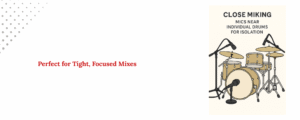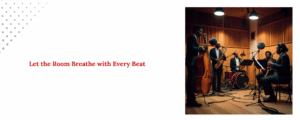Where you put the microphone makes a big difference in how well you record drums. To do it, you can either mic up close or mic up far away. Picking the right one, or even mixing the two, can make a big difference in how your drums sound. We’ll talk in this article about the pros and cons of each way in this guide to help you decide which one might work best for your song.
How Do You Do Close Miking?
When you close the mic, you put the mics very close to each drum—usually only an inch or two away. This technique is often used in studio records of rock, pop, and metal music where clarity, punch, and control are important.
Close Miking Has Benefits Like Isolation and Control
The result of mic up close is the pure sound of each drum with minimal effect of other instruments. This allows the artist to have more effect on the mix, thereby applying effects, EQ and compression to each drum in a more definitive manner.
To Be Clear and Hit
The mic is very close, so the rapid reaction is very clear and sharp. The attack of the kick and snare makes the mix stand out, which is great for songs with a lot of energy and movement. Learn more about kick drum miking techniques.
Not as Much Room to Move
When you mic up close, the room’s audio signature is reduced, which is helpful in neglected or bad-sounding spaces.
Cons of Close Miking
- It Doesn’t Create Natural Ambiance
There are other things besides drums. Without surrounding room mics, close miking can make the sound dry and artificial. - Uses a Lot of Time Setting Up
Microphoning each part (kick, snare, toms, hi-hats, etc.) needs more gear, more time, and careful phase synchronization to keep comb filtering from happening. You can check out drum mic kits for beginners for convenient solutions.
What Does Distant Miking Mean?
When speaking to more distant speakers who are usually 1 to 2 feet away from the drum kit this is known as distant miking or room miking. It records a greater amount of space, a greater amount of the drums, and how the sound of all percussion parts on the drum kit combine together, instantly.
Natural Sound and Depth
Room mics give you a feeling of space and realism, which are both benefits of distant miking. Because the room reflects and resonates, the drum sound is deeper and more three-dimensional.
Easy Living
Setting up and mixing can go faster with fewer mics, especially in jazz, classical, or lo-fi styles that like an organic sound.
Life Force and Vibe
The extra background noise can give the drums more energy, making them sound more “live” and exciting. For example, it works really well with punk rock, atmospheric, or movie music.
Room Dependency Is a Problem with Distant Miking
Room sounds have of huge influence on the quality of recording. When you fail to treat a place correctly, then it will have unwanted echoes, muddiness, or noise.
Less Control Over Each Person
When you mix drums with only faraway mics, it’s harder to work on individual parts. Want more snare? The whole kit could be affected by what you do.
When to Use Close Miking
For Genres That Need Accuracy
Drums tracks should be tight and controlled, which suit pop, rock, hip-hop, metal, and EDM.
In Places With Bad Acoustics
Close miking lessens the effect of bad room acoustics.
You can program echo on just the snare or squeeze the toms separately when you mic them close. This is useful for mixing complex sounds.
When to Use Natural or Live-Sounding Music from Away
For Natural Sound
The natural sound of room mics is great for jazz, folk, classical, and acoustic music.
In Well-Treated Studios
A room with good sound quality can improve faraway miking by adding natural, lush echo.
Creative or Ambient Productions
Room mics can give your experimental or ambient music the sound you want.
Combining Close and Room Mics for a Full Drum Sound
A lot of current drum tracks use both close and far away mics. This mixed method catches both the detailed attack of close mics and the wide ambience of room mics, giving you the most mixing options.
Typical Hybrid Setup
- Close mics on the kick, snare, and toms are a common part of a hybrid setup.
- Using stereo mics above the drums and the whole kit to get a good sound.
- Room mics are set up 6 to 10 feet away to get real space and noise.
- A single room mic is optional for extra glue and punch.
This way, you can mix the dry and wet signals however you like, moving the kit forward or backward in the mix as needed. If you’re wondering whether investing in premium mics makes a difference, check out this comparison of budget vs. high-end drum mics.




